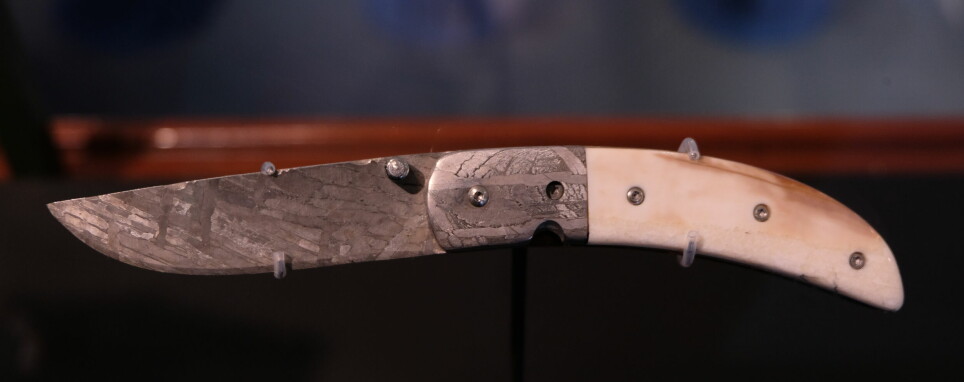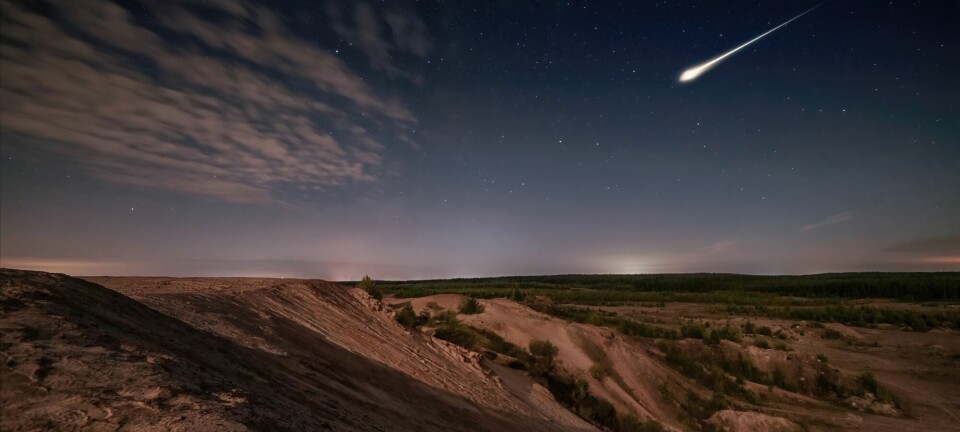
The blade of this knife is from space
Can you imagine how that can be?
Us humans have mastered creating various items for thousands of years.
Knives, beads and jewellery are among these things.
Iron from the ground has to be heated and separated from other elements before we can use it.
Even so, archaeologists have found items made of iron before humans knew how to extract and separate it from the ground.
So where did that iron come from then?
Space.

Meteoritic iron
“Some of the oldest items made of iron that we have found are made of iron from space,” says archaeologist Lisbeth Skogstrand.
This iron has made its way to our planet via meteorites.
This is for instance the case with the meteorite Campo del Cielo. It fell down in Argentina more than 4000 years ago, and was used to make weapons.
“Meteoritic iron can be used as it is. This means that humans could make tools of iron before we figured out how to extract it,” she says.
The Egyptian pharaoh Tutankhamun was buried with among other things an iron knife. The boy King lived 3000 years ago, and died before humankind had mastered the art of extracting iron. In 2016, researchers established that the blade of the knife must have come from a meteorite.

No need to destroy to study
“We have wondered here the first iron came from. It’s a long time since somebody suggested that it could have come from meteorites, but it’s been rather difficult to actually establish this for sure,” says Skogstrand.
Today researchers have the possibility to examine what something is made of without having to destroy the thing itself.
“With better methods and equipment, researchers are now able to get lots of new information without having to make holes in the items,” Skogstrand says.
The researchers use small measuring devices that shoot signals into the metal.
“This in turn produces a sort of echo that tells you what basic elements the item consists of,” she says.
The iron in meteorites from space often contain nickel. This separates this type of iron from the iron that humans have extracted from earth.
Is it possible then to find a meteorite when you’re out and about for a walk?
“Yes, that is totally possible!” Skogstrand says.
“After millions of years, quite a few meteorites have fallen from space and landed on earth,” she says.
Send us your samples!
If you’re in Norway and you believe that you’ve found a meteorite, you can send a piece of it or a photo to the Natural History Museum in Oslo.
These will most likely be received by meteorite-expert Morten Bilet. Or is it meteor-expert? What’s the difference, anyways?
“A lot of people mix these two words up. A meteor is a rock which lights up in the sky. If it survives its trip through the atmosphere and hits the ground it’s called a meteorite,” Bilet says.
Meteorites are usually black on the outside, a little lighter on the inside, and often have rounded edges. They are also twice as heavy as a normal rock.

Big as a building
“That rock that you’re left with in your hand, has also become a lot smaller on its way to earth,” Bilet says.
The reason for this is that a lot of it burns off on the way through the atmosphere and toward earth.
And thank goodness for that.
One meteorite that fell down in Chelyabinsk in Russia in 2013 would otherwise have been the size of a large apartment block. Luckily, most of it burned off before hitting earth. The blast from the meteor still injured lots of people and buildings.
Bilet encourages people to question whether or not what they’ve found might be a meteorite.
You can use a compass to investigate this yourself. If the arrow on the compass moves when it’s near the stone, then it’s magnetic. And this may suggest that it is in fact a meteorite.
Translated by: Ida Irene Bergstrøm
------
You can read the Norwegian version of this article on ung.forskning.no

































